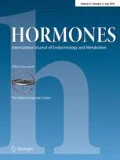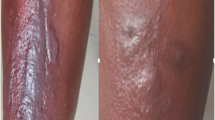Abstract
Pretibial myxedema (PM) is a rare extrathyroidal manifestation of Graves’ disease (GD), usually during the hyperthyroid state, coexisting with orbitopathy. We describe a rare case of a biopsy-proven PM in a euthyroid patient, without history of GD or Hashimoto’s thyroiditis. Assessment of commonly reported thyroid autoantibodies, such as thyroid peroxidase and thyroglobulin autoantibodies, thyroid stimulating immunoglobulins and thyroid binding inhibitory immunoglobulins, was negative. Resolution of skin pathology was achieved after topical application of corticosteroids and was sustained 1 year later.
Similar content being viewed by others
Introduction
Pretibial myxedema (PM) is a rare extrathyroidal manifestation of Graves’ disease (GD), occurring in about 1–5% of patients and usually coexisting with Graves’ orbitopathy [1, 2]. PM constitutes one of the classical forms of dermopathy in GD, presenting with a broad range of symptomatology (from asymptomatic erythema to the severe elephantiasic form) [1, 2]. PM usually occurs during the hyperthyroid state of GD [1, 2]. PM has also rarely been described in patients with Hashimoto’s thyroiditis [3]. We present a rare case of a biopsy-proven PM manifesting in a euthyroid patient with no history of GD or Hashimoto’s thyroiditis.
Case presentation
A 61-year-old Caucasian woman attended our outpatient dermatology clinic for evaluation and management of itchy bilateral erythema involving the lower two-thirds of the pretibial regions. Her medical history was remarkable for subtotal thyroidectomy due to non-toxic multinodular goiter 15 years previously (unfortunately, no histopathological data were available). There was no history of thyrotoxicosis or ophthalmopathy. The medical history also included breast cancer, type 2 diabetes mellitus (T2DM), and arterial hypertension. The patient was a non-smoker and did not consume any alcohol. Apart from thyroxine, the patient was also on letrozole, sitagliptin/metformin, glimepiride, olmesartan, and moxonidine.
Clinical examination revealed the presence of bilateral, edematous pretibial erythema with “peau d’orange” appearance. No signs of ophthalmopathy or acropathy were observed. The patient was euthyroid with negative thyroid peroxidase (TPO-Ab), thyroglobulin autoantibodies (Tg-Ab), thyroid-stimulating immunoglobulins (TSI), and thyroid-binding inhibitory immunoglobulins (TBII). Neck ultrasonography revealed the presence of a significant thyroid remnant, with mildly heterogeneous echogenity, without nodules. Due to the non-typical manifestation, a skin biopsy was performed, which was consistent with PM. Specifically, it revealed edema of the reticular dermis presenting as empty slit-like spaces separating collagen fibers, with normal fibroblasts. Stellate fibroblasts (myofibroblasts) in the papillary dermis and perivascular infiltrate of lymphocytes were also observed. The histochemical stain showed a mild increase of acid mucopolysaccharides in the papillary dermis (Fig. 1a). The patient was successfully treated with topical application of corticosteroids, showing significant amelioration of her lesions 1 month later which persisted 12 months after therapy (Fig. 1b).
Discussion
The main pathogenetic mechanism of PM involves the expression of TSH-receptor antigen in skin fibroblasts, which triggers an autoimmune response, leading to the production of large amounts of glycosaminoglycans and their accumulation in the dermis and subcutaneous tissue [2]. PM mainly occurs in patients with high TSI titers [2]. However, the presence of autoantibodies inhibiting the binding of TSH to its receptor (TBII) has also been described [2]. The coexistence of typical pretibial skin lesions, a history of GD, and ophthalmopathy establishes the diagnosis of PM. In cases in which definitive diagnosis is debated, skin biopsy is suggested [2]. Histopathology usually shows deposition of mucin/glycosaminoglycan among the dermal collagen fibers in the dermis, along with lymphocytic infiltration in most cases, without affecting the epidermis [2, 4]. The differential diagnosis includes simple edema as a result of fluid retention or venus insufficiency, chronic lichenified dermatitis, hypertrophic lichen planus, urticarial phase of bullous pemphigoid or, rarely, papular, follicular, or reticular erythematous mucinosis [2, 3].
To the best of our knowledge, PM in euthyroid patients has also been reported in another six cases in the literature [3, 5,6,7,8,9]. The absence of the commonly assessed thyroid autoantibodies (TPO-Ab, Tg-Ab, TSI, TBII) was evident in two of them [5, 6] and positive thyroid autoantibodies (either TSI or TPO-Ab, Tg-Ab,) in another two [3, 7], while in two other cases, there were no available data regarding thyroid autoantibody tests [8, 9]. There is no plausible explanation for this rare manifestation of PM in our patient. One could hypothesize the presence of autoantibodies binding to the TSH-receptor but devoid of TBII or TSI activity, which are not detected with common assays. Of course, we also cannot exclude the presence of thyroiditis, since 15% of hypothyroid patients have negative autoantibodies but an ultrasound pattern consistent with thyroiditis.
Conclusion
In conclusion, we describe a rare case of a biopsy-proven PM manifesting in a euthyroid patient, without prior history of GD or Hashimoto’s thyroiditis. Assessment of commonly reported thyroid autoantibodies, such as TPO-Ab, Tg-Ab, TSI, and TBII, was negative. Resolution of skin pathology was achieved and sustained after topical application of corticosteroids. Thus, the negative history of GD and common thyroid autoimmunity tests should not exclude the diagnosis of PM.
References
Anagnostis P, Adamidou F, Polyzos SA, Katergari S, Karathanasi E, Zouli C, Panagiotou A, Kita M (2013) Predictors of long-term remission in patients with Graves’ disease: a single center experience. Endocrine 44:448–453
Fatourechi V (2005) Pretibial myxedema: pathophysiology and treatment options. Am J Clin Dermatol 6:295–309
Nair PA, Mishra A, Chaudhary A (2014) Pretibial myxedema associated with euthyroid Hashimoto’s thyroiditis: a case report. J Clin Diagn Res 8:YD01–YD02
Somach SC, Helm TN, Lawlor KB, Bergfeld WF, Bass J (1993) Pretibial mucin. Histologic patterns and clinical correlation. Arch Dermatol 129:1152–1256
Buljan-Cvijanovic M, Neal JM, Zemtsov A (1998) Euthyroid pretibial myxedema. Endocr Pract 4:375–377
Chen JJ, Ladenson PW (1987) Euthyroid pretibial myxedema. Am J Med 82:318–320
Senel E, Güleç AT (2009) Euthyroid pretibial myxedema and EMO syndrome. Acta Dermatovenerol Alp Pannonica Adriat 108:21–23
Srebrnik A, Ophir J, Brenner S (1992) Euthyroid pretibial myxedema. Int J Dermatol 31:431–432
Greer MA (1957) Exophthalmos and localized pretibial myxedema in a euthyroid patient; studies with triiodothyronine. J Clin Endocrinol Metab 17:1466–1471
Author information
Authors and Affiliations
Corresponding author
Ethics declarations
Conflict of interest
The authors have no conflict of interest to disclose.
Rights and permissions
About this article
Cite this article
Anagnostis, P., Artzouchaltzi, A., Grekou, A. et al. Pretibial myxedema in a euthyroid patient. Hormones 17, 133–135 (2018). https://doi.org/10.1007/s42000-018-0008-6
Received:
Accepted:
Published:
Issue Date:
DOI: https://doi.org/10.1007/s42000-018-0008-6





